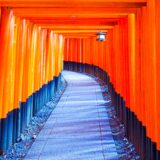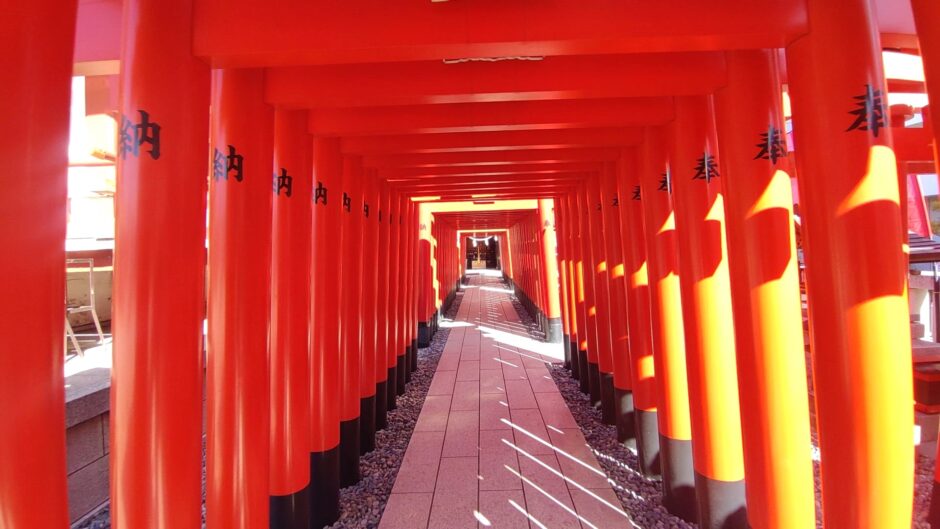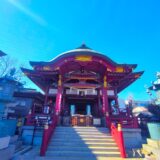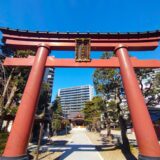目次
- 【Anamori Inari Shrine summary】
- 【Anamori Inari Shrine precincts】
- 【Anamori Inari Shrine Senbon Torii gate】
- 【Anamori Inari Shrine Inariyama (inari-zan) (Mt. Inari)】
- 【Anamori Inari Shrine subordinate shrine】
- 【Anamori Inari Shrine GOSHUIN】
- 【The former Ichi-no-Otorii (Great Gate) of the former Anamori Inari Shrine】
- 【Haneda Shichifuku Inari Shirauo Inari Shrine】
- 【Haneda Shichifuku Inari Kamomeinari Shrine】
- 【Anamori Inari Shrine Nearby attractions】
- 【Anamori Inari Shrine Access】
- Manager’s Comments
- Anamori Inari Shrine
【Anamori Inari Shrine summary】
Anamori Inari Shrine was built in the late Edo period (1804-1831). At that time, a man named Yagoemon Suzuki lived in Haneda Hunters’ Town. He noticed the tidal flat to the east of Haneda Ura and decided to build a dike across the several-mile-long tidal flat to develop new fields. Yaemon built a shrine on the embankment and prayed for a good harvest and safe shipping. The origin of the company’s name is said to mean “Inari, the great god of harvest, who protects the fields from the damage caused by holes drilled by waves.
![Anamori Inari Shrine [Tokyo] DSC 1836 2 1024x768 - Anamori Inari Shrine [Tokyo]](https://japan-shrine.info/wp-content/uploads/DSC_1836-2-1024x768.jpg)
It was originally located near the current Haneda Airport runway B, but was reclaimed by the U.S. military after the war’s end. Later, thanks to the efforts of local residents, it was reconstructed at its current location.
The deity is Toyokehime no Mikoto, who is enshrined at the outer shrine of Ise Jingu.
![Anamori Inari Shrine [Tokyo] DSC 0376 160x160 - Anamori Inari Shrine [Tokyo]](https://japan-shrine.info/wp-content/uploads/DSC_0376-160x160.jpg) Toyoke Grand Shrine (Outer Shrine of Ise Jingu) [Mie]
Toyoke Grand Shrine (Outer Shrine of Ise Jingu) [Mie]
【Anamori Inari Shrine precincts】
![Anamori Inari Shrine [Tokyo] DSC 1795 1024x768 - Anamori Inari Shrine [Tokyo]](https://japan-shrine.info/wp-content/uploads/DSC_1795-1024x768.jpg)
Passing through the torii gate and up the stairs is the beautiful main shrine.
![Anamori Inari Shrine [Tokyo] DSC 1798 1024x768 - Anamori Inari Shrine [Tokyo]](https://japan-shrine.info/wp-content/uploads/DSC_1798-1024x768.jpg)
From the side of the hall of worship, there are various Inari shrines such as Prosperity Inari, Success Inari, Kaiun Inari, and Hissho Inari at the Senbon Torii gate.
【Anamori Inari Shrine Senbon Torii gate】
![Anamori Inari Shrine [Tokyo] DSC 1801 2 1024x768 - Anamori Inari Shrine [Tokyo]](https://japan-shrine.info/wp-content/uploads/DSC_1801-2-1024x768.jpg)
The size of the Senbon-torii and the length of the approach are not comparable to Fushimi Inari in Kyoto, but as a Senbon-torii on a flat approach, it is the closest in Tokyo in terms of atmosphere.
 Fushimi Inari-taisha Shrine [Kyoto]
Fushimi Inari-taisha Shrine [Kyoto]
Senbon-torii in Tokyo are located at the following shrines.
![Anamori Inari Shrine [Tokyo] DSC 1820 1 1024x768 - Anamori Inari Shrine [Tokyo]](https://japan-shrine.info/wp-content/uploads/DSC_1820-1-1024x768.jpg)
Beyond the torii gate are stairs to the inner shrine and Mt.
【Anamori Inari Shrine Inariyama (inari-zan) (Mt. Inari)】
![Anamori Inari Shrine [Tokyo] DSC 1805^2 1024x768 - Anamori Inari Shrine [Tokyo]](https://japan-shrine.info/wp-content/uploads/DSC_1805%5E2-1024x768.jpg)
The stairway is built like a building, but there is an Ontake Shrine at the top.
![Anamori Inari Shrine [Tokyo] DSC 1812 1 1024x768 - Anamori Inari Shrine [Tokyo]](https://japan-shrine.info/wp-content/uploads/DSC_1812-1-1024x768.jpg)
I was surprised at the unexpected height of Mt. After climbing down, I noticed that there is a pagoda called “Sazae-do” in Aizu. It has a similar double spiral structure, with one-way traffic going around and around the tower, and then going up and down. The tower is one-way, so that climbers and descenders do not pass each other.
![Anamori Inari Shrine [Tokyo] DSC 0893 160x160 - Anamori Inari Shrine [Tokyo]](https://japan-shrine.info/wp-content/uploads/DSC_0893-160x160.jpg) Sazae Temple [Fukushima]
Sazae Temple [Fukushima]
Descending Mt. Inari, there are more fox mounds, aviation inari, and gojindana.
【Anamori Inari Shrine subordinate shrine】
![Anamori Inari Shrine [Tokyo] DSC 1818 1024x768 - Anamori Inari Shrine [Tokyo]](https://japan-shrine.info/wp-content/uploads/DSC_1818-1024x768.jpg)
Several shrine pavilions are enshrined within the shrine territory, all of which are guarded by foxes.
【Anamori Inari Shrine GOSHUIN】
![Anamori Inari Shrine [Tokyo] 2025 02 15 15 19 Office Lens 714x1024 - Anamori Inari Shrine [Tokyo]](https://japan-shrine.info/wp-content/uploads/2025_02_15-15_19-Office-Lens-714x1024.jpg)
【The former Ichi-no-Otorii (Great Gate) of the former Anamori Inari Shrine】
![Anamori Inari Shrine [Tokyo] DSC 1854 1024x768 - Anamori Inari Shrine [Tokyo]](https://japan-shrine.info/wp-content/uploads/DSC_1854-1024x768.jpg)
Google Map shows it as the former Ichi-no-torii of Anamori Inari Shrine, but it faces away from Anamori Inari Shrine, there is no shrine beyond the torii, and a bell is attached to the torii, which is disconcerting to those who love shrines. The torii gate is probably a reconstruction by another organization of the Ichino-torii gate abandoned by the former Anamori Inari Shrine, and has nothing to do with the current Anamori Inari Shrine.I wonder if this is a scar from the forced relocation by the US military…
It is said that the shrine is very crowded on New Year’s Day and sunrise because of its good view.
【Haneda Shichifuku Inari Shirauo Inari Shrine】
![Anamori Inari Shrine [Tokyo] DSC 1845 1024x768 - Anamori Inari Shrine [Tokyo]](https://japan-shrine.info/wp-content/uploads/DSC_1845-1024x768.jpg)
On the way from Anamoriinari to the old Otorii (Grand Gate), there is Shirauoinari Shrine, one of the Seven Gods of Good Fortune in Haneda. It is said that the shrine was dedicated to the first white fish caught in Haneda. It is surrounded by roads and residential areas, and the site is a parking lot.
【Haneda Shichifuku Inari Kamomeinari Shrine】
![Anamori Inari Shrine [Tokyo] DSC 1862 1024x768 - Anamori Inari Shrine [Tokyo]](https://japan-shrine.info/wp-content/uploads/DSC_1862-1024x768.jpg)
About a 10-minute walk from Anamori Inari Shrine is Kamomeinari Shrine. It is said that when fishermen prayed, a large flock of seagulls flew to the shrine, resulting in a great catch of fish, hence the name “Seagull Inari Shrine.
![Anamori Inari Shrine [Tokyo] DSC 1863 1024x768 - Anamori Inari Shrine [Tokyo]](https://japan-shrine.info/wp-content/uploads/DSC_1863-1024x768.jpg)
The shrine cat was waiting for me. Thanks for your hard work.
【Anamori Inari Shrine Nearby attractions】
Haneda Airport, Haneda Shrine
【Anamori Inari Shrine Access】
Manager’s Comments
It is a very well-maintained and well-loved shrine. Inari is said to bring prosperity to the region and local business. Historically, fishing and farming were thriving in this area. Therefore, there are many small Inari shrines, and there is an event to visit seven Inari shrines, which seems to have taken root in the community.
 Tour of Japanese shrines and temples
Tour of Japanese shrines and temples 

![Anamori Inari Shrine [Tokyo] DSC 0494 Object Removal 520x300 - Anamori Inari Shrine [Tokyo]](https://japan-shrine.info/wp-content/uploads/DSC_0494_Object-Removal-520x300.jpg)
![Anamori Inari Shrine [Tokyo] DSC 1374 520x300 - Anamori Inari Shrine [Tokyo]](https://japan-shrine.info/wp-content/uploads/DSC_1374-520x300.jpg)
![Anamori Inari Shrine [Tokyo] DSC 0696 520x300 - Anamori Inari Shrine [Tokyo]](https://japan-shrine.info/wp-content/uploads/DSC_0696-520x300.jpg)
![Anamori Inari Shrine [Tokyo] DSC 1876 2 520x300 - Anamori Inari Shrine [Tokyo]](https://japan-shrine.info/wp-content/uploads/DSC_1876-2-520x300.jpg)
![Anamori Inari Shrine [Tokyo] 7d20a3950a8470d96435e24619588840 - Anamori Inari Shrine [Tokyo]](https://japan-shrine.info/wp-content/uploads/sng/7d20a3950a8470d96435e24619588840.png)
![Anamori Inari Shrine [Tokyo] DSC 1876 2 150x150 - Anamori Inari Shrine [Tokyo]](https://japan-shrine.info/wp-content/uploads/DSC_1876-2-150x150.jpg)
![Anamori Inari Shrine [Tokyo] DSC 1374 150x150 - Anamori Inari Shrine [Tokyo]](https://japan-shrine.info/wp-content/uploads/DSC_1374-150x150.jpg)
![Anamori Inari Shrine [Tokyo] DSC 0851 2 150x150 - Anamori Inari Shrine [Tokyo]](https://japan-shrine.info/wp-content/uploads/DSC_0851_2-150x150.jpg)
![Anamori Inari Shrine [Tokyo] DSC 0630 150x150 - Anamori Inari Shrine [Tokyo]](https://japan-shrine.info/wp-content/uploads/DSC_0630-150x150.jpg)

